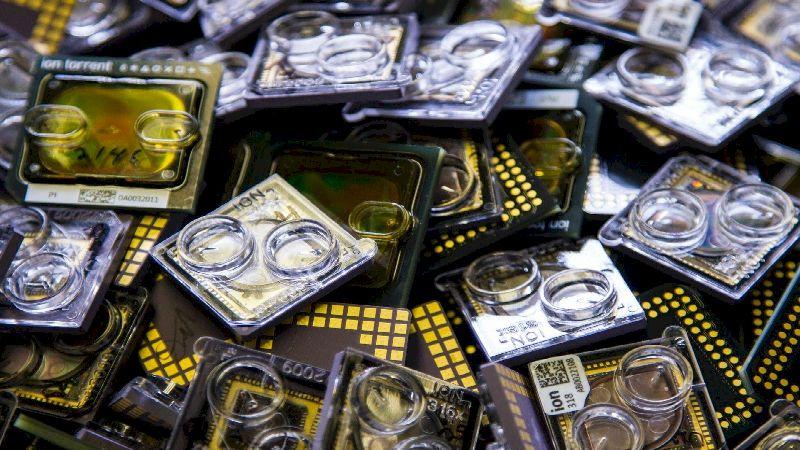
Photo by National Cancer Institute on Unsplash
Like a magnet that helps in searching for a needle in a haystack, biologists use biosensors to detect minute concentrations of a specific molecule in a solution containing different molecules. These sensors contain an array of specially designed molecules called receptors that can bind to selected molecules. Some applications such as measuring trace quantities of DNA having a small mutation in a pool of other genes require highly sensitive biosensors.
In a new study, researchers from the Indian Institute of Technology Bombay (IIT Bombay) present a theoretical method to quantify and improve the sensitivity of biosensors. This method identifies critical parameters that dictate the detection of minute quantities of target molecules suspended in a solution with a large concentration of other molecules. The study was published in the journal ACS Sensors and was supported by DST INSPIRE Faculty Fellowship and Visvesvaraya Young Faculty Fellowship.
A commonly used type of biosensor, called ‘endpoint sensor’, relies on the number of molecules captured on the sensor surface after a set time to estimate the concentration of a target molecule in the solution. Any undesired molecule attached to the receptor at this point is erroneously counted while target molecules that might have detached already are discounted. Such a scheme may have serious limitations if the concentration of undesired molecules is significantly greater than the target molecules in the solution.
On the other hand, ‘dynamic tracking biosensors’ can provide real-time information about the interactions between the receptors and molecules. Researchers can trace the time-stamp of interactions between target and receptors, which helps in getting a more accurate count of the target molecules.
“Endpoint sensors and dynamic tracking biosensors, in the end, tell you the concentration of the molecules. But factors such as time taken for stable experimental reading, the detection limits, the complexity and the cost of the technology determine which scheme to go for,” explains Prof Pradeep Nair. He is an Associate Professor at IIT Bombay and the senior author of this study.
In a dynamic tracking biosensor, due to the specific nature of interactions between target and receptor molecules, the target molecules will latch on to the receptors for a long time while undesired molecules are released sooner. It is clearly possible then to distinguish between desired and undesired molecules based on their time of interaction with the receptors.
The researchers generated a mathematical model to determine the ideal time threshold that can define the boundary between the two categories of molecules. Any molecule that is bound to the receptors for longer than the calculated threshold time is considered a target molecule and is counted in the final concentration value. The model takes in data about the total number of receptors bound to the target and non-target molecules respectively, and the dissociation rates of the molecules, which is the inverse of the average time taken by the molecules to unbind from the receptor.
The researchers found that the model could predict the correct threshold times even when the details of the chemical association between the target and receptor molecules are unknown. They ran different simulations, where either only the dissociation rate of the target molecule was known or no information was available about both types of molecules, and tracked all unbinding events occurring at the receptor. In both cases, the threshold time to estimate the target concentration was the same as the value predicted by their mathematical model.
“The model can predict the threshold time only when the target and non-target molecules show a difference in their attachment affinity. If the target attaches to the receptor for 50 seconds and the non-target also attaches for 50 seconds, then there is no way that the two can be separated,” adds Prof Nair.
While all these calculations might be precise theoretically, there is always a chance of error in its practical use. Dynamic tracking works on the principle of time-locked observation of the receptors of a biosensor. This presents two sources of error: first, the time spent in observing the receptor interaction, and second, the number of receptors that are under scrutiny. The researchers found an inverse relationship between these factors and the measurement error. Hence, increasing the time or number of receptors will reduce the value of error. However, it is technologically challenging to measure each unbinding event at every receptor for an extended period.
The researchers say that there is room for improvement in dynamic tracking technology. “For example, we need to figure out how to keep track of the binding and unbinding events at the receptors and how to tag the target molecules for efficient observation,” says Prof Nair. “But compared to the endpoint detection methods, it will be much more technologically evolved, and far more superior in terms of the detection limits.” He is doubtful though that it will be used for regular cases, like in glucose biosensors, soon. “But I am sure that it will be an emerging and highly sensitive technology,” he concludes.
This article has been run past the researchers, whose work is covered, to ensure accuracy.






